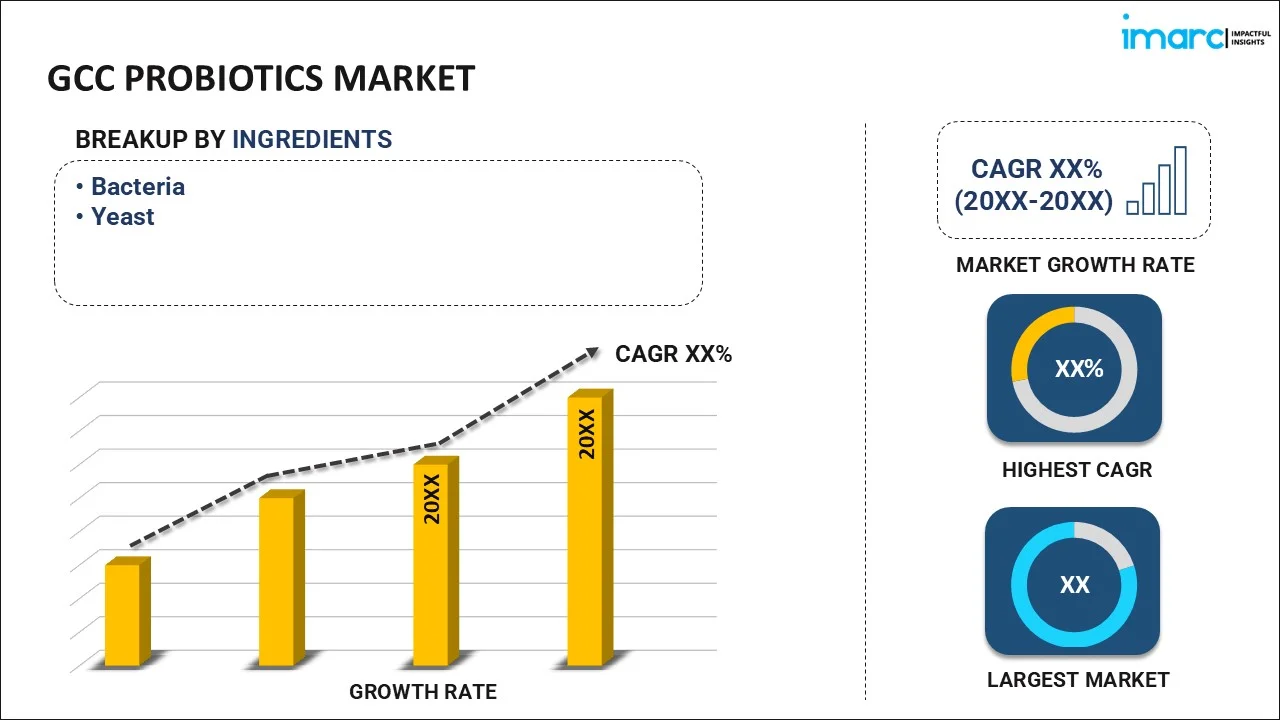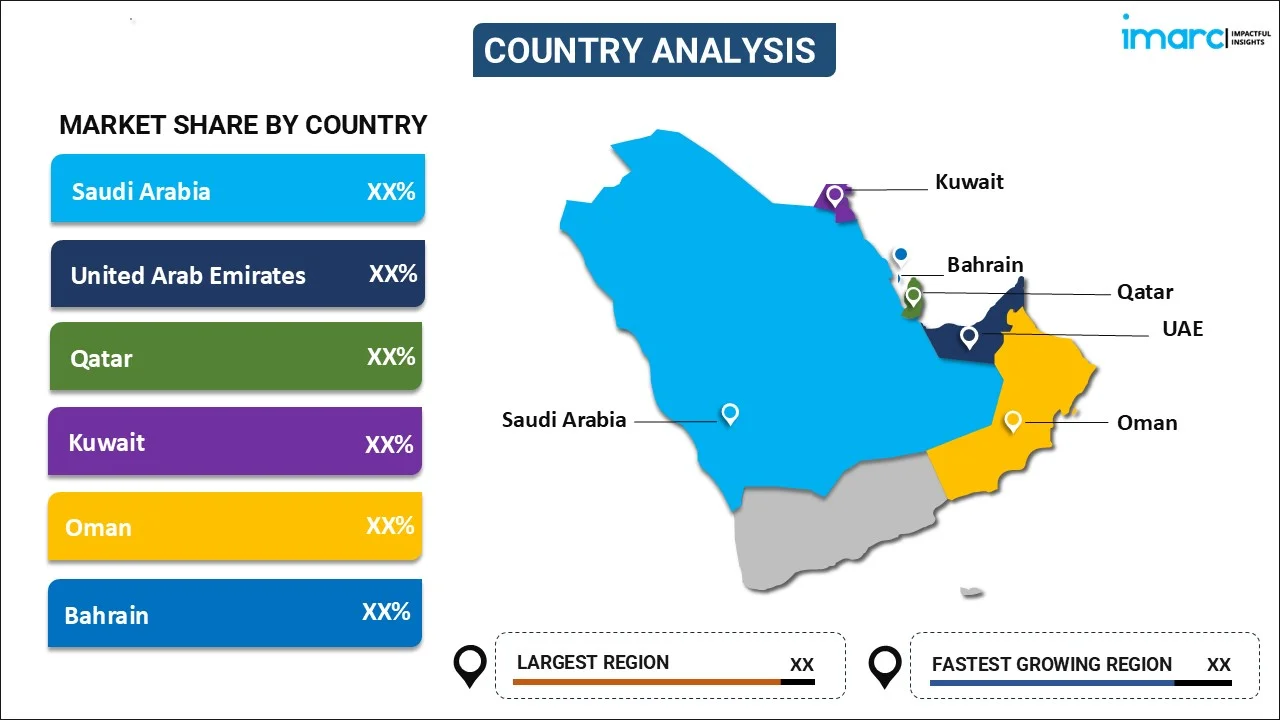
GCC Probiotics Market Report by Ingredient (Bacteria, Yeast), Distribution Channel (Supermarkets and Hypermarkets, Pharmacies/Drugstores, Specialty Stores, Online Stores, and Others), Application (Food and Beverages, Dietary Supplements, Animal Feed), Form (Dry, Liquid), and Country 2024-2032
Market Overview:
The GCC probiotics market size is projected to exhibit a growth rate (CAGR) of 7.7% during 2024-2032. Increasing health awareness, rising lifestyle-related disorders, higher disposable incomes, expanding product portfolios, digital health information dissemination, and governmental health initiatives represent some of the key factors driving the market.
|
Report Attribute
|
Key Statistics
|
|---|---|
|
Base Year
|
2023
|
|
Forecast Years
|
2024-2032
|
|
Historical Years
|
2018-2023
|
| Market Growth Rate 2024-2032 | 7.7% |
Probiotics are live microorganisms, primarily bacteria and some yeasts, that offer potential health benefits when consumed in adequate amounts. These "good" bacteria are known to provide a positive influence on the balance of the gut microbiota, which is the complex community of microorganisms residing in the digestive tract. Probiotics exert their effects through various mechanisms. They can help maintain a balanced microbial environment by competing with harmful bacteria for resources and attachment sites in the gut lining. Additionally, they can produce substances that promote the growth of beneficial bacteria and create an environment less conducive to pathogenic organisms. This, in turn, enhances digestion, nutrient absorption, and overall gut health. Probiotics are commonly found in fermented foods such as yogurt, kefir, sauerkraut, kimchi, and certain cheeses. They are also available as dietary supplements.
GCC Probiotics Market Trends:
The growth of the GCC probiotics market is propelled by the growing demand for these beneficial microorganisms across the region. Besides this, increasing awareness of health and wellness among the population has prompted a shift towards preventive healthcare measures, fueling interest in probiotics due to their perceived positive impact on digestive health and overall well-being. Moreover, as the GCC nations witness a rising prevalence of lifestyle-related disorders, such as obesity, diabetes, and gastrointestinal issues, individuals are seeking natural and alternative solutions like probiotics, creating a positive outlook for market expansion. Concurrent with this, rapid urbanization, changing dietary habits, and the adoption of a more Westernized diet have led to an upsurge in gastrointestinal problems, spurring the demand for products that can address these concerns. Additionally, the GCC's flourishing economy and higher disposable incomes have allowed consumers to invest in premium health products, including probiotics, to proactively manage their health, thereby bolstering the market growth. In line with this, the digital age has facilitated the dissemination of health information, enabling consumers to become more informed about the benefits of probiotics and driving their inclination toward incorporating these products into their daily routines. Furthermore, an increasing prevalence of lactose intolerance and dairy-related sensitivities, leading to a surge in demand for non-dairy probiotic options, such as plant-based yogurts and kefir, is contributing to the market’s growth. Apart from this, extensive research and development (R&D) efforts aimed at uncovering new potential benefits of probiotics, such as immune system support and mental well-being, and favorable governmental initiatives promoting healthier lifestyles and preventing chronic diseases are strengthening the market growth.
GCC Probiotics Market Segmentation:
IMARC Group provides an analysis of the key trends in each segment of the GCC probiotics market report, along with forecasts at the regional and country levels for 2024-2032. Our report has categorized the market based on ingredient, distribution channel, application, and form.
Ingredient Insights:

- Bacteria
- Yeast
The report has provided a detailed breakup and analysis of the market based on the ingredient. This includes bacteria and yeast.
Distribution Channel Insights:
- Supermarkets and Hypermarkets
- Pharmacies/Drugstores
- Specialty Stores
- Online Stores
- Others
A detailed breakup and analysis of the market based on the distribution channel has also been provided in the report. This includes supermarkets and hypermarkets, pharmacies/drugstores, specialty stores, online stores, and others.
Application Insights:
- Food and Beverages
- Dietary Supplements
- Animal Feed
The report has provided a detailed breakup and analysis of the market based on the application. This includes food and beverages, dietary supplements, and animal feed.
Form Insights:
- Dry
- Liquid
A detailed breakup and analysis of the market based on the form has also been provided in the report. This includes dry and liquid.
Country Insights:

- Saudi Arabia
- UAE
- Qatar
- Oman
- Kuwait
- Bahrain
The report has also provided a comprehensive analysis of all the major regional markets, which include Saudi Arabia, UAE, Qatar, Bahrain, Kuwait, and Oman.
Competitive Landscape:
The report has also provided a comprehensive analysis of the competitive landscape in the market. Competitive analysis such as market structure, key player positioning, top winning strategies, competitive dashboard, and company evaluation quadrant has been covered in the report. Also, detailed profiles of all major companies have been provided.
GCC Probiotics Market Report Coverage:
| Report Features | Details |
|---|---|
| Base Year of the Analysis | 2023 |
| Historical Period | 2018-2023 |
| Forecast Period | 2024-2032 |
| Units | US$ Million |
| Scope of the Report | Exploration of Historical and Forecast Trends, Industry Catalysts and Challenges, Segment-Wise Historical and Predictive Market Assessment:
|
| Ingredients Covered | Bacteria, Yeast |
| Distribution Channels Covered | Supermarkets and Hypermarkets, Pharmacies/Drugstores, Specialty Stores, Online Stores, Others |
| Applications Covered | Food and Beverages, Dietary Supplements, Animal Feed |
| Forms Covered | Dry, Liquid |
| Countries Covered | Saudi Arabia, UAE, Qatar, Bahrain, Kuwait, Oman |
| Customization Scope | 10% Free Customization |
| Report Price and Purchase Option | Single User License: US$ 3699 Five User License: US$ 4699 Corporate License: US$ 5699 |
| Post-Sale Analyst Support | 10-12 Weeks |
| Delivery Format | PDF and Excel through Email (We can also provide the editable version of the report in PPT/Word format on special request) |
Key Questions Answered in This Report:
- How has the GCC probiotics market performed so far and how will it perform in the coming years?
- What has been the impact of COVID-19 on the GCC probiotics market?
- What is the breakup of the GCC probiotics market on the basis of ingredient?
- What is the breakup of the GCC probiotics market on the basis of distribution channel?
- What is the breakup of the GCC probiotics market on the basis of application?
- What is the breakup of the GCC probiotics market on the basis of form?
- What are the various stages in the value chain of the GCC probiotics market?
- What are the key driving factors and challenges in the GCC probiotics market?
- What is the structure of the GCC probiotics market and who are the key players?
- What is the degree of competition in the GCC probiotics market?
Key Benefits for Stakeholders:
- IMARC’s report offers a comprehensive quantitative analysis of various market segments, historical and current market trends, market forecasts, and dynamics of the GCC probiotics market from 2018-2032.
- The research study provides the latest information on the market drivers, challenges, and opportunities in the GCC probiotics market.
- Porter's five forces analysis assist stakeholders in assessing the impact of new entrants, competitive rivalry, supplier power, buyer power, and the threat of substitution. It helps stakeholders to analyze the level of competition within the GCC probiotics industry and its attractiveness.
- Competitive landscape allows stakeholders to understand their competitive environment and provides an insight into the current positions of key players in the market.
Need more help?
- Speak to our experienced analysts for insights on the current market scenarios.
- Include additional segments and countries to customize the report as per your requirement.
- Gain an unparalleled competitive advantage in your domain by understanding how to utilize the report and positively impacting your operations and revenue.
- For further assistance, please connect with our analysts.
 Inquire Before Buying
Inquire Before Buying
 Speak to an Analyst
Speak to an Analyst
 Request Brochure
Request Brochure
 Request Customization
Request Customization




.webp)




.webp)












